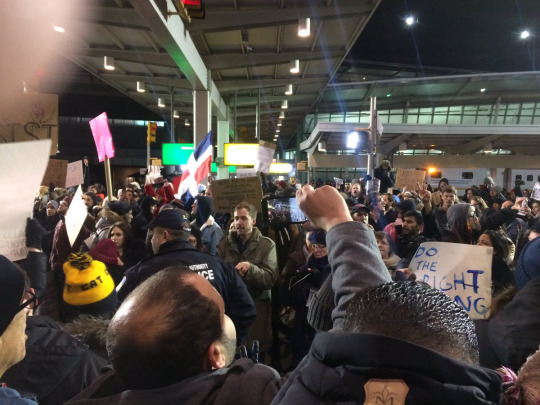Archive for January 31, 2017
‘The Affair’ thoughts, Season Three, Episode Ten
January 31, 2017Thinking back, all four main characters’ stories end in a place of relative equilibrium, so much so that it seems likely this episode was set up to serve as a series finale if need be. Noah has found peace, if not a purpose. Helen has come clean and her family has remained intact despite it all. Cole has decided to remain unhappily married to Luisa. Alison has her daughter and a new career and the self-knowledge, if not necessarily the desire or ability, to make a fresh go of things. The murder mystery and the attempted murder mystery have both been wrapped up. “Where we goin’, buddy?” I don’t know, but I’ll be there next season to find out.
John F. Kennedy International Airport, January 28, 2017
January 31, 2017


“The Young Pope” thoughts, Season One, Episode Six
January 31, 2017Send cardinals, nuns, and money – the shit has hit the fan.
Nine months after Pope Pius XIII announced his intention to rule the Catholic Church with an iron fist (wearing a red velvet glove covered in gold rings, natch), the effects of his fundamentalist fervor are being felt far and wide. August officials are dropping dead in the cafeteria. Renegade mystics are disappearing. Church pews are quite literally collapsing. Police are investigating and the priesthood is being purged. Jimmy crack corn, and the Young Pope doesn’t care.
“The Young Pope” thoughts, Season One, Episode Five
January 31, 2017…the high point is the address to the College of Cardinals, an act of absolutely unsurpassed arrogance and imperial menace. To the visible and audible shock of the assembly, the Pope is carried into the Sistine Chapel on a throne, carried on the shoulders of a dozen priests. Fan-bearers flank him like an actual Roman emperor. His costumery is so ornate and massive that he’s all but immobile in it, his head pivoting and malevolent eyes twinkling amid the mountain of cloth and gold like a character out of Alice in Wonderland.
His speech is a dictatorial masterpiece: an outright call to his brother cardinals to purge the Church of all but its most fanatical followers, to act as aloof and above the unfaithful masses as God Himself. It’s one of the greatest speeches in TV history, placed at the apex of the best television episode of the year. And it ends with a display of outright dominance: Pius extends his foot, and one by one, his mentor Cardinal Spencer, his best friend Cardinal Dussolier, and his defeated nemesis Cardinal Voiello come forward to kiss it. He is the Young Pope. Bow down.
I reviewed Sunday’s The Young Pope, the best episode of television I’ve seen in months, for Rolling Stone. I literally cried tears of joy and delight watching this thing.
The Boiled Leather Audio Hour Episode 59
January 31, 2017Political Special: Trump, Week One
Our last episode isn’t even a week old and our most recent BLAM subscriber-exclusive episode isn’t even a day old, but events are moving so quickly in America right now, and have such resonance with our interests as readers, writers, and thinkers, that we’re back already with an extra podcast for the month. Returning to the real-world political themes of past episodes on the 2016 presidential election and the Third Reich, Sean and Stefan discuss the stunning first week of the Trump regime. Drawing comparisons to past strains of fascist and authoritarian start, we attempt to predict what’s coming from Trump, his supporters, and his opponents; debate the efficacy of institutionalism versus radical change; and search for signs of hope. Sean also calls for a general strike to remove Trump from office, so that’s exciting. (Please note that this episode was recorded just over 24 hours ago, so it does not take into account the fresh fascist horrors that have occurred in the interim.)
And remember, if you like what you hear, subscribe to our Patreon to hear more of it via our subscriber-exclusive Boiled Leather Audio Moment mini-podcast.
Our BLAH episode on the election.
Our BLAH episode on the Third Reich.
The latest BLAM mini-episode (click to subscribe).
Our Patreon page at patreon.com/boiledleatheraudiohour.
Our PayPal donation page (also accessible via boiledleather.com).
The Boiled Leather Audio Moment #2!
January 31, 2017Moment 02 | Our Origin Stories
The second installment of our subscriber-only mini-podcast series is here! In this episode we’re answering a popular reader question about our personal histories with A Song of Ice and Fire—when we started reading the books, how we got involved in the fandom, and so on. We also attempt to predict what will become of all this once the book series is finished. Click here to listen, or to subscribe for the low low introductory rate of just $1 a month!
The Boiled Leather Audio Hour Episode 58!
January 27, 2017Rogue One: A Star Wars Podcast
Rebellions are built on hope, and this episode of the Boiled Leather Audio Hour is built on Rogue One: A Star Wars Story! Stefan and Sean continue their exploration of that galaxy far, far away with a look at Gareth Edwards’s stand-alone contribution to the Star Wars cinematic universe. How does it stack up against The Force Awakens? What’s the impact of its countless cameos and Easter eggs on the one hand and its unprecedented-for-the-franchise story structure on the other? How do we feel about Edwards’s handling of action, character, setting, performance, and the all important “toyetic” factor? Hit play and find out!
And remember, if you like what you hear, subscribe to our Patreon to hear more of it via our subscriber-exclusive Boiled Leather Audio Moment mini-podcast!
Our BLAH episode on the prequel trilogy.
Our BLAH episode on The Force Awakens.
Sean’s article comparing Rogue One to TFA for Rolling Stone.
Sean’s list of the 57 Greatest Star Wars moments for Vulture.
Our Patreon page at patreon.com/boiledleatheraudiohour.
Our PayPal donation page (also accessible via boiledleather.com).
“The Path” thoughts, Season Two, Episode Two: “Dead Moon”
January 25, 2017It may be about a religion, but The Path has become business-y. I don’t mean that in the sense of Cal, Sarah, and company pursuing the financial expansion of the Meyerist movement. I mean the business each character is required to go through to fill up an episode. Think of it this way: You’ve got X number of storylines, and Y number of characters, and you need to do something with all of them, right? A good show makes this look easy and effortless even when the painstaking care involved is readily apparent. The characters’ interests, hopes, drives, and fears feel like they emerged from within a recognizable and cohesive personality. Their interactions have a continuity with previous interactions. They do things because they need to do them, not because the show needs them to do them to run out the clock. When those elements erode, you wind up with a show that feels like everyone’s doing busywork — moving from place to place and person to person, picking fights and patching things up, changing and re-changing their minds about important topics just to have something to do. It gets business-y. And that’s where The Path has led.
“The Path” thoughts, Season Two, Episode One: “Liminal Twilight”
January 25, 2017If you’re in the business of grading TV shows, The Path is the very definition of a solid B. Created by Jessica Goldberg, Hulu’s original drama about a small Scientology-style cult and its increasingly fractured membership takes its intriguing premise and does exactly what’s needed to get it across, no more and no less. Led by Breaking Bad’s Aaron Paul, who’s a producer on the show as well, the cast is a who’s who of actors from other, mostly (but not always) better, prestige-TV projects. Michelle Monaghan (True Detective) and Hugh Dancy (Hannibal), Paul’s co-leads, are the most prominent of course; to them you can add Emma Greenwell (Shameless), Brian Stokes Mitchell (Mr. Robot), Rockmond Dunbar (Sons of Anarchy), Peter Friedman and Deirdre O’Connell (The Affair), Ali Ahn (Billions, a show that took a similar Peak TV Grab Bag approach to casting), and so on. All of them do good work; none of them do their best work. When you’re coming off all-time great shows like Paul and Dancy are, the difference is hard to ignore.
The scripts split their time fairly evenly between the plot, broadly involving the power struggles and loss of faith that stem from the cult’s L. Ron Hubbard-esque leader’s hushed-up illness and death, and intense but uncomplicated exploration of the characters’ conflicted feelings about their faith and their families. The story is involving, the writing adequate and rarely memorable as writing. The filmmaking is as neutral a view on the action as a seat in the mezzanine looking at a proscenium stage; its attempts at surrealism, whether in dream sequences or psychedelic-drug hallucinations, don’t linger or haunt. (This is especially glaring when Dancy is involved; every time he comes across some bog-standard symbolism, like an owl watching him in the woods, I can’t help but wonder if he recalls his time on Hannibal and thinks “that thing should be made of human tendons and its beak should gush blood.”) Its sole genuine innovation is an animated opening-credits sequence that entirely eschews the stately dark montage approach of pretty much every other prestige show on television — which is not to say it’s good, it looks like a commercial for a fibromyalgia medication, but at least it’s different. All told, The Path is an engaging way to spend your spare time, but you’re not likely to make like the cult members and reorganize your life around it.
“Taboo” thoughts, Episode Three
January 25, 2017Appropriately enough, the third episode of Taboo opens with a shot of muck. Already TV’s most dirt-encrusted show by a substantial margin, Steven Knight and Tom Hardy’s period-piece opus reached new levels of physical filthiness in tonight’s go-round. When lead character James Keziah Delaney (played by Hardy) turns to actor Michael Kelly’s American spy for lifesaving surgery, the doc’s teeth are so rotten they’re practically orange. When James staggers home to clean and dress the wound, you can barely see blood beneath the layers of grime. When he unearths a mysterious symbol from the fireplace in his late mother’s room, he winds up looking like he used his own body to sweep the chimney. Like the gag from Monty Python and the Holy Grail about being able to recognize the king simply because “he hasn’t got shit all over him,” Taboo is out to paint the town brown.
Which is not to say it traffics solely in the disgusting. On the contrary, if you’re a fan of Hardy’s thighs — and who isn’t? — there’s much to enjoy here. Whether he’s recuperating from his assassination attempt, wading through his flooded cellar (where the water comes in so frequently, it literally ebbs and flows with the tide), or sitting cross-legged after a nightmarish vision of a crow-cloaked, white-faced sorceress, he seems to do his best work pantsless. Hardy cuts a different figure when he’s wearing nothing but an oversized shirt than he does when he’s striding around London in all-black everything, but it’s fair to say the overall effect is equally impressive.
Lord of the Thighs: I reviewed last night’s episode of Taboo for Vulture.
Artcrime: What “Beware the Slenderman” Says About Blaming Artists for Violence
January 25, 2017There is no artist behind Slender Man, not in the panoptic, memetic form in which Morgan and Anissa encountered him. Slender Man’s “author” is the internet and the army of artists and writers and filmmakers and game designers who inhabit it. Only the accident of history, in which the original posts can be tracked down, enables us to put names to the faceless being at all. A few decades ago Slender Man would just be Bloody Mary or the killer with a hook for a hand who disrupts teenagers necking in their cars. A few centuries ago and he’d be the vampire a town feared enough to dig up graves and behead the corpses inside, or the witch who lures wayward children to their doom. With no artist in play, it becomes clear how fallacious it is to pin the blame on artists for the actions of disturbed individuals who consumed their art at all.
This is not to say art never affects society or inspires terrible things. When Jared Kushner crows about targeting ads for his odious father-in-law Donald Trump’s presidential campaign to viewers of The Walking Dead because of their concerns about immigration, he’s recognizing the fascist ideology that underlies both the show and the current administration. But art with an ideological vector connects the reader or viewer to a cohesive worldview, which, right or wrong, helps explain society and prescribe remedies for its ills. Action and reaction are to be expected.
That’s different from a movie about a pair of abused kids who become mass murderers and media superstars, or music by a glam-influenced Satanist, or creepy internet posts about a demon with no face. These merely provide monsters who embody fears and desires, not a political program. Those monsters will always exist in one form or another, and disturbed kids like Morgan and Anissa will always find them and use them as the mold into which they pour their crumbling sanity or mounting bloodlust. In blaming the art or the artist, we commit the exact same error, looking for a boogeyman to help us explain the inexplicable. We’re finding our own Slender Man to serve.
“The Young Pope” thoughts, Season One, Episode Four
January 24, 2017It’s not TV. It’s The Young Pope.
We hope HBO will pardon our repurposing of their famous catchphrase for the sake of celebrating what creator Paolo Sorrentino, star Jude Law and everyone else involved in this extraordinary pulp-prestige TV project have wrought. But hey, if the slogan fits, wear it. Flip the channels or scroll through the streaming services all you want, but you won’t find anything like this. Its combination of tightly controlled tone with beautifully bizarre flights of fancy and absolutely colossal camp stands alone. It’s Hannibal for lapsed Catholics.
I reviewed last night’s episode of The Young Pope for Rolling Stone. It was excellent as always. But let me tell you this: Nothing can prepare you for next Sunday’s episode. I literally wept tears of joy.
“The Affair” thoughts, Season Three, Episode Nine
January 23, 2017“The Young Pope” thoughts, Season One, Episode Three
January 23, 2017Next up is the opening credit sequence that launched a thousand fan tumblrs. As an instrumental version of “All Along the Watchtower” plays, Pius walks in slow motion past a series of famous religious paintings as a comet soars through the sky in each of them, tracing his progress. (This is a symbol dating back to one of the Medici popes, Clement VII, and is said to indicate either great good or great misfortune.) With a shit-eating grin on his face and the credits emblazoned in flickering neon blue on the wall behind him, he eventually turns directly to the viewer … and winks. Nothing is sacred here, not even the fourth wall. At the end of his stroll, he passes a life-sized statue of beloved Pope John Paul II, which is then promptly bowled over by the now-extinguished comet. (This is itself a sculpture called “La Nona Ora (The Night Hour)” by artist Maurizio Cattelan.) Eat meteor, JPII!
I reviewed tonight’s marvelous episode of The Young Pope for Rolling Stone.
Women’s March NYC
January 21, 2017


The 25 Most Anticipated TV Shows of 2017
January 19, 2017TWIN PEAKS
Showtime, May 21
“I’ll see you again in 25 years”: Ok, so the ghost of Laura Palmer may have wound up being off by a year or so when she uttered these immortal words to Agent Dale Cooper. But hey, better late than never. As it stands, the return of David Lynch and Mark Frosts’s seminal small-town–noir series – arguably the most influential show for TV’s New Golden Age – will pick up with much of the original cast, including Kyle MacLachlan as Coop and Sherilyn Fenn as Audrey Horne, in tow; everyone from Laura Dern to Trent Reznor and Eddie Vedder are slated for cameos. The original Peaks was both heartbreakingly empathetic and pants-pissingly scary; there’s no reason to expect the Lynch-directed Season Three won’t follow suit. STC
“Taboo” thoughts, Episode Two
January 19, 2017All due respect to the East India Company, but James Keziah Delaney has a new nemesis in town, and his name is Pius XIII. That’s right: We’re all stars in the Pope Show, and that’s the stage upon which Taboo co-creators Steven Wright and Tom Hardy now find themselves forced to perform. The Young Pope is undoubtedly a love-it-or-leave-it proposition, but it’s also a marvel of artifice and audacity that makes Taboo look positively tame, no matter how many tribal tattoos fit on Hardy’s nude body.
Of course, this second episode of Taboo has more going against it than stiff competition. For all the care put into constructing a convincingly squalid 19th-century London, Knight’s script too often feels like a first draft. For example: “Am I the only one in this company with a brain?” asks malevolent Sir Stuart Strange, after his East India underlings fail to grasp the nuances of his latest monologue. It’s the kind of line that could have been turned into something clever, and thus illustrated the character’s point, if it were given 30 extra seconds of thought.
“The Young Pope” thoughts, Season One, Episode Two
January 17, 2017That’s the beauty of The Young Pope: Like all truly great television shows, it trusts its audience enough to risk alienating us. What will people make of this episode’s most bizarre scene, in which Pius supernaturally soothes a savage … kangaroo? It’s so truly, madly, deeply odd, and showrunner Paolo Sorrentino has no interest in softening the blow. You make your peace with an exquisitely campy series about a chain-smoking homophobic tyrant who looks to the band behind “Get Lucky” and “One More Time” for stylistic inspiration; who was raised by a nun who thinks he’s a saint but wears a t-shirt reading “I’m a Virgin, but This Is an Old Shirt” to bed; and who can calm rogue Australian wildlife like, as Voiello puts it in his thick Italian accent, “Saint Francis of-a Sydney.” Or you don’t. If the meme-able moments make it all sound silly, well, remember when an O.J. Simpson show from the creator of Glee starring John Travolta, David Schwimmer, and Cuba Gooding Jr. sounded silly, too? We rest our case.
“The Affair” thoughts, Season Three, Episode Eight
January 16, 2017Hey, remember when The Affair wasn’t The Noah Solloway Show? Believe it or not, there was such a time not so long ago. Noah’s story — his stint in prison, his torment at the hands of sadistic guard John Gunther, his post-release trysts with Alison and Helen and (sorta) his new romantic interest Irène, his attempted murder, his infection and addiction, his hallucinations, his secret origin as his mother’s euthanasia provider — have come to dominate the show so totally that I’d all but forgotten what it was like to truly see things through other eyes. Not just his own, I mean, but those people who have something other than Noah Solloway on their minds.
This week, that’s what we got. If episode seven was a return to The Affair’s old format — two tightly overlapping points of view on the same events — episode eight is a return to The Affair’s old setting, both physically and psychologically. Taking place almost entirely in Montauk, as beautifully shot as ever, this Alison/Cole installment focuses squarely on the issues that drove their stories since the show’s inception: grief, loss, infidelity, and the sense of being connected by something deeper than love — tragedy.
“I think people see what they want to see in other people:” I reviewed last night’s episode of The Affair for Decider.
“The Young Pope” thoughts, Season One, Episode One
January 15, 2017“We have forgotten to masturbate!”
So proclaims Pope Pius XIII to the adoring throngs gathered in St. Peter’s Square to hear the first homily of his papacy. Yet when it comes to the jaw-dropping moments in the premiere episode of The Young Pope, the Holy Father’s ode to onanism barely even makes the Top 10.
Italian writer-director Paolo Sorrentino kicks off his highly anticipated series with the surreal dream-image of the new pope emerging from a literal mountain of dead and dying babies. He follows it up with not one but two shots of the pontiff’s bare ass before we’re five minutes in. The smug religious leader then slo-mo struts through a teeming crowd of priests, nuns and cardinals whose multi-colored garb looks might like something out of Game of Thrones‘ – if they weren’t, you know, what Catholic clergy really wear. He has a split-second flashback to seeing a topless woman in his youth. He looks up and hey, there’s a water cooler lit like it’s a visitor from God. His adoring underlings form stunning tableaux in shot after shot, like something out of R.E.M.’s “Losing My Religion” video. He glides to the balcony to give his speech as if attached to the camera, like Harvey Keitel when he gets loaded in Mean Streets. A graphic overlay of black bars slowly spread across the screen, emblazoned with the series’ title. His lunatic grin is the only thing that’s visible.
Pius XIII takes the proverbial stage to the screams of thousands, arms outstretched like a rock star, grinning and gesticulating like his name was Monsignor Mussolini. Rain clouds are parted with a wave of his hands, and out comes the sun. Then, with a gorgeously old-fashioned zoom-in and drum buildup, he drops that masturbation line, the first explosion in a carpet-bombing campaign of unorthodoxy: Why not have extramarital sex, gay marriage, nuns saying mass? In reaction, shocked prelates collapse backwards in unison like they’re in the final panel of a gag cartoon. Panicked priests run through the Vatican halls, screaming for help. Only the intervention of his second-in-command, summarily firing him from the papacy, tips the show’s hand that this was just a dream.
But when this young Pope, a 47-year-old American named Lenny Belardo and played by Jude Law, wakes up from his nightmare, it doesn’t feel like a cop-out. On the contrary, the twist works like a charm, because everything here – from the writing to the cinematography, the score to the performances – is honest-to-God dreamy. The show does the same thing its title character is supposed to do as the leader of the Catholic Church: It provides a breath of madcap fresh air in a dreary, homogeneous TV season.
